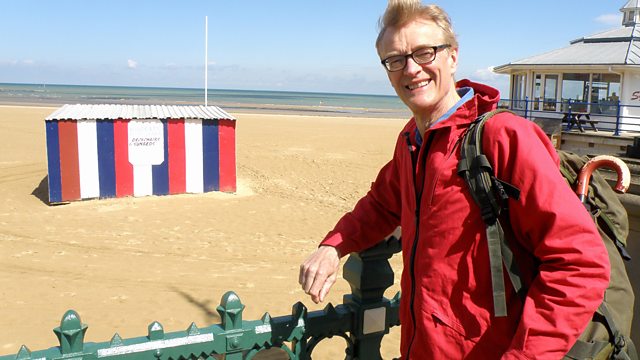Anglesey Coast

Similar Content
Browse content similar to Anglesey. Check below for episodes and series from the same categories and more!
Transcript
| Line | From | To | |
|---|---|---|---|
In 1748, a Welsh map maker described the port of Amlwch | 0:00:30 | 0:00:35 | |
as an "insignificant harbour that is not worth mapping". | 0:00:35 | 0:00:39 | |
But barely 20 years later, that insignificant harbour | 0:00:39 | 0:00:42 | |
became the most important port in Wales. | 0:00:42 | 0:00:45 | |
Dotted all around are relics of early industry, proof that this site was once a hive of activity. | 0:00:52 | 0:00:59 | |
So what went on here? | 0:00:59 | 0:01:01 | |
And what happened to it all? | 0:01:01 | 0:01:02 | |
This abandoned road originally ran all the way from the hillside above | 0:01:04 | 0:01:08 | |
me to the port down there, and it's known locally as the Copper Road. | 0:01:08 | 0:01:13 | |
The name is the first clue to what's going on. | 0:01:13 | 0:01:18 | |
Anglesey is incredibly rich in copper ore. | 0:01:18 | 0:01:22 | |
In 1768, a particularly rich vein of copper was unearthed here on Parys Mountain. | 0:01:22 | 0:01:28 | |
Local geologist David Jenkins is going to show me the dramatic impact that discovery had on the landscape. | 0:01:28 | 0:01:36 | |
Wow, that is incredible! Just look at the colours, the scale of it. | 0:01:38 | 0:01:44 | |
Looks like the kind of hole of a meteorite would make after it smashed into the earth. | 0:01:44 | 0:01:49 | |
And yet, essentially, it was done by hand. | 0:01:51 | 0:01:55 | |
At one point there were about 1,500 miners | 0:01:55 | 0:01:57 | |
working down here excavating this hole, | 0:01:57 | 0:02:00 | |
blasting with black powder, so it must have been an incredible place. | 0:02:00 | 0:02:04 | |
Very spectacular. | 0:02:04 | 0:02:06 | |
But turning this potential mountain of money | 0:02:07 | 0:02:11 | |
into hard cash meant arduous, back-breaking work for thousands. | 0:02:11 | 0:02:16 | |
This is a fragment of what was called a cobbing floor. | 0:02:17 | 0:02:20 | |
This was a yard where the ore was delivered to women working in sheds, | 0:02:20 | 0:02:26 | |
and they would break up the ore into small pieces, and the ones with ore in they would keep and it would go | 0:02:26 | 0:02:32 | |
for roasting and smelting, and the waste rock, that would be thrown down and... | 0:02:32 | 0:02:37 | |
So all this rubbish around here was built up on rubbish? | 0:02:37 | 0:02:42 | |
12 hours and they got 10p, that was their reward for hard labour. | 0:02:42 | 0:02:47 | |
I'm getting nowhere here! Oh, what's that? | 0:02:49 | 0:02:52 | |
-Yes, that's a... -It's like gold, isn't it? | 0:02:52 | 0:02:55 | |
Looks very similar to gold. | 0:02:55 | 0:02:57 | |
Slightly greenier. Oh, you might have got your 10p for this! | 0:02:57 | 0:03:01 | |
To cash in, they had to transport thousands of tonnes of copper ore off the island. | 0:03:01 | 0:03:07 | |
So some 240 years ago the tiny nearby port of Amlwch was transformed. | 0:03:09 | 0:03:15 | |
That mammoth enterprise has been researched by local historian Brian Hope. | 0:03:16 | 0:03:23 | |
The smelter was up at the top there, | 0:03:23 | 0:03:26 | |
and the wind, as it's blowing today, billowing smoke out to sea, | 0:03:26 | 0:03:30 | |
and there were complaints the entrance to the harbour couldn't be found because of that. | 0:03:30 | 0:03:35 | |
-Pretty toxic smoke I guess, wasn't it? -Well, make you cough! | 0:03:35 | 0:03:38 | |
Where were the ships sailing to when they left here loaded with copper ore? | 0:03:38 | 0:03:41 | |
Mainly to Swansea, to the Crown smelters there. | 0:03:41 | 0:03:44 | |
After all, Swansea was Copperopolis. | 0:03:44 | 0:03:47 | |
The copper from this area dominated the world's market in the 1780s. | 0:03:48 | 0:03:53 | |
It was used to copper bottom boats, mint coins and fashion ornaments. | 0:03:53 | 0:03:59 | |
But time was running out. | 0:04:01 | 0:04:03 | |
The remaining copper was harder to reach. | 0:04:03 | 0:04:06 | |
By the late 1800s, after nearly 100 years, the Amlwch copper rush came to an end. | 0:04:06 | 0:04:14 | |
But maybe the story of Parys Mountain isn't over. | 0:04:17 | 0:04:20 | |
Perhaps it's just on hold. | 0:04:20 | 0:04:22 | |
The amazing colours of the landscape indicate that it's still rich in minerals. | 0:04:22 | 0:04:29 | |
There's copper, lead and zinc, and even a sprinkling of gold and silver. | 0:04:29 | 0:04:35 | |
There may be a time when demand for the precious metals | 0:04:38 | 0:04:41 | |
buried behind the coast of Anglesey make it economic for miners to return to Parys Mountain. | 0:04:41 | 0:04:47 |